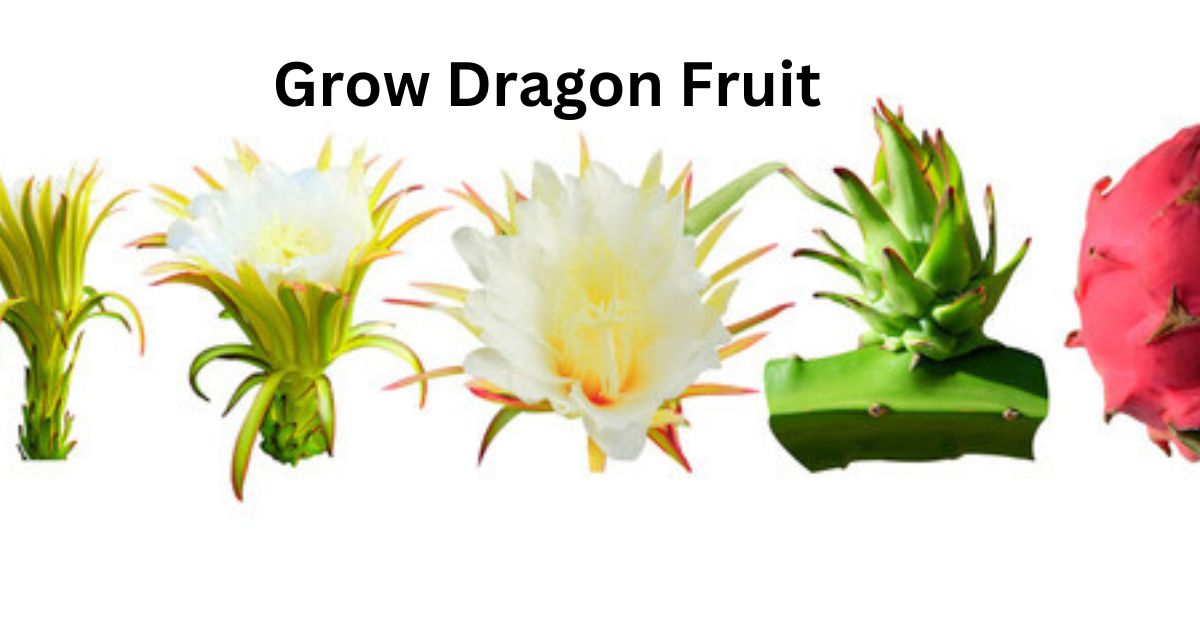
Transform your backyard into a tropical paradise! Learn how to grow dragon fruit at home with this easy-to-follow guide. Discover the rewards and challenges of cultivating this exotic, vibrant fruit.
Introduction
Dreaming of growing your own tropical fruit at home? Dragon fruit, with its bright pink skin and sweet, refreshing flesh, is a perfect choice for anyone looking to add a touch of the exotic to their garden. While the idea of cultivating this striking fruit may seem intimidating, it’s more achievable than you might think. This beginner’s guide will walk you through the process of growing dragon fruit in your backyard, from planting to harvest.
Why Grow Dragon Fruit?
1. Exotic and Beautiful
Dragon fruit plants bring an exotic vibe to your garden. Their striking flowers and vibrant fruit add a tropical charm that’s sure to impress guests.
2. Low Maintenance
Once established, dragon fruit plants are drought-tolerant and require minimal care, making them perfect for gardeners seeking a relatively low-maintenance plant.
3. Nutritional Benefits
Dragon fruit is packed with antioxidants, vitamins, and fiber. Growing your own ensures you enjoy fresh, pesticide-free fruit straight from your garden.
4. Sustainable Gardening
Dragon fruit thrives in arid climates and requires little water, making it a sustainable option for eco-conscious gardeners.
5. A Fun Challenge
Growing dragon fruit is a unique gardening adventure that’s as rewarding as it is enjoyable. Watching your plant flourish and eventually bear fruit is a satisfying experience.
Challenges of Growing Dragon Fruit
Before you begin, it’s essential to understand the potential challenges
1. Climate Needs
Dragon fruit thrives in warm, tropical climates. If you live in a cooler region, you’ll need to take steps to protect the plant from frost.
2. Patience Required
Dragon fruit plants can take a few years to mature and produce fruit, so patience is key.
3. Space Considerations
These plants can grow large and require ample space, as well as sturdy support for climbing.
4. Pollination Needs
In some cases, you may need to hand-pollinate the flowers to ensure fruit production, especially if natural pollinators are scarce in your area.
5. Pest and Disease Management
Like any plant, dragon fruit is susceptible to pests like mealybugs and diseases such as fungal infections. Regular monitoring is crucial.
How to Grow Dragon Fruit
Step 1: Choose the Right Location
Select a sunny spot in your garden that gets 6-8 hours of direct sunlight daily. Ensure the soil is well-draining, as dragon fruit roots are prone to rot in waterlogged soil.
Step 2: Propagation
Cuttings: Cuttings are the most popular way to grow dragon fruit. Take healthy cuttings from mature plants, let them dry and callus for a few days, then plant them in well-draining soil.
Seeds: Growing from seed is possible but requires patience, as it can take several years before the plant bears fruit.
Step 3: Provide Support
Dragon fruit plants are climbing cacti and need sturdy support to grow. Install a trellis, pole, or fence for the plant to climb.
Step 4: Watering and Soil Care
Water deeply but infrequently. Allow the soil to dry out slightly between waterings to prevent root rot. Avoid overwatering, especially during cooler months.
Step 5: Fertilizing
Feed your dragon fruit plant monthly during the growing season with a balanced fertilizer. Organic options like compost or manure can also be beneficial.
Step 6: Pruning
Regularly prune your plant to remove dead or overcrowded stems. This encourages new growth, improves air circulation, and keeps the plant manageable.
| Step | Instructions | Tips & Considerations |
| 1. Choose a Variety | Select a variety suitable for your climate. Consider factors like fruit color, size, and sweetness. | Research varieties known for their adaptability to your region. |
| 2. Prepare the Soil | Ensure well-draining soil rich in organic matter. Amend with compost or well-rotted manure. | Avoid heavy clay soils that retain water. |
| 3. Choose a Location | Plant in a sunny location with at least 6 hours of direct sunlight daily. | Protect from strong winds that can damage the plant. |
| 4. Plant the Cutting | Plant the cutting horizontally or vertically, ensuring good contact with the soil. | Water thoroughly after planting. |
| 5. Provide Support | Install a sturdy trellis or fence for the plant to climb. | Regular pruning may be necessary to maintain the desired shape. |
| 6. Water Regularly | Water deeply and consistently, especially during dry periods. | Avoid overwatering, which can lead to root rot. |
| 7. Fertilize Regularly | Use a balanced fertilizer monthly during the growing season. | Consider using organic fertilizers like compost tea or fish emulsion. |
| 8. Protect from Pests & Diseases | Monitor for pests like mealybugs and scale insects. | Use organic pest control methods like neem oil or insecticidal soap. |
| 9. Harvest | Harvest fruits when they are ripe and slightly soft to the touch. | Ripe fruits will easily detach from the plant. |
Tips for Success
1. Protect from Frost
If you live in a region with cold winters, protect your plants by covering them with frost blankets or bringing potted plants indoors.
2. Watch for Pests and Diseases
Inspect your plants frequently for signs of pests like scale insects and mealybugs. Treat infestations early with insecticidal soap or neem oil.
3. Hand Pollination
If natural pollinators like bees or bats are scarce, you may need to hand-pollinate the flowers using a soft brush to transfer pollen between flowers.
4. Mulch for Moisture
Add a layer of mulch around the base of the plant to retain soil moisture and suppress weeds.
5. Enjoy the Process
Growing dragon fruit is a journey that requires patience and care. Embrace the process and enjoy watching your plant thrive over time.
Harvesting Dragon Fruit
Once your dragon fruit plant matures and flowers, it will begin producing fruit. Here’s how to know when it’s ready to harvest:
The fruit should be brightly colored, with smooth, evenly toned skin.
Gently press the fruit—it should feel firm but not hard.
Use a sharp knife or pruning shears to cut the fruit from the plant. Enjoy it fresh, in smoothies, or as a topping for desserts!
Why Grow Dragon Fruit Is Worth the Effort
Growing dragon fruit at home is a truly rewarding experience. Not only do you get to enjoy fresh, home grow dragon fruit, but you also gain the satisfaction of cultivating an exotic plant. Its vibrant blooms and striking fruit make it a conversation starter, and the process of nurturing the plant is a fulfilling gardening project.
Conclusion
Grow Dragon fruit cultivation might seem challenging at first, but with the right knowledge and care, you can successfully grow this stunning fruit in your backyard. From selecting the right location and providing support to mastering watering and pruning techniques, every step of the journey brings you closer to enjoying your very own homegrown dragon fruit.
Whether you’re an experienced gardener or just starting, grow dragon fruit adds a unique touch to your garden and rewards you with delicious, nutritious fruit. Start your dragon fruit growing adventure today and create your very own tropical oasis at home.






Pingback: Unleash the Dragon: Explore the Colorful World of Dragon Fruit Workshops 2025 -
Pingback: Companion Planting for Thriving Dragon Fruit